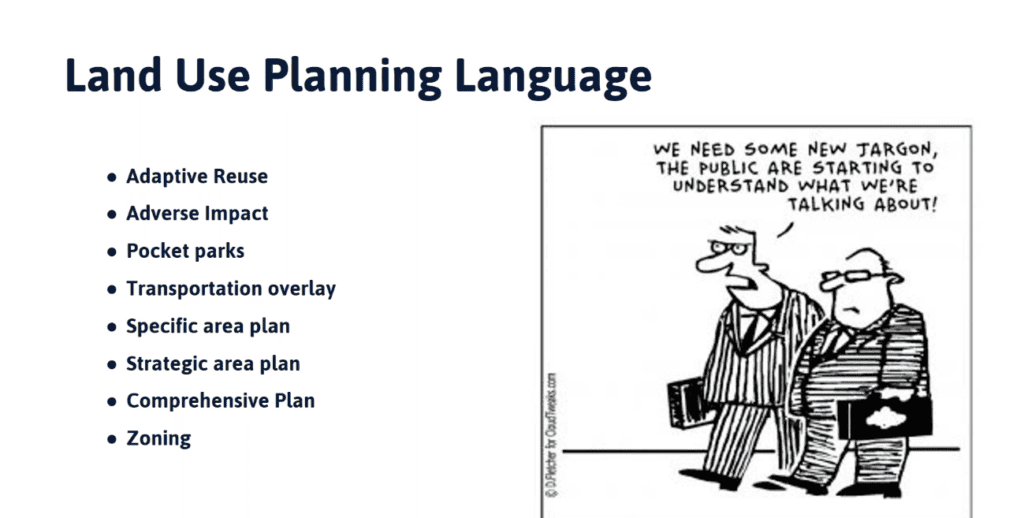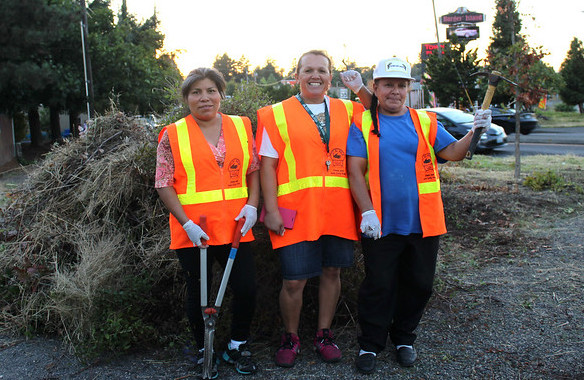This month we were grateful to co-host the Twitter Chat, How to Address Transportation Equity for Latino Communities, hosted by Salud America as part of their regular #SaludTues Twitter Chats. Check out this recap of our points and some supportive links to relevant resources.
1. In what ways has an ethnocentric approach to urban and transportation planning effected Latino communities?
At the most basic level, planning, hiring and industry norms that lack intentional inclusion of Latinos, and ones that default to a white-centered or ethnocentric approach, will always fail Latino communities.
This breeds a range of inequities and dysfunction in our work and communities: Latino men and Latina women are underutilized in DOT work, walkable community outreach doesn’t meaningfully engage Latinos and low-income populations in decision-making, and more.
And to quote Angie Schmitt, “A lot of times Black and Latino neighborhoods of color are being passed over for safety improvements that white communities have, sort of, the political clout to secure.”
2. How do current auto-centric practices and policies undermine efforts to improve transportation equity in Latino communities?
Auto-centric practices/policies deepen inequities of Latino communities that often rely on transit and active transportation more heavily than white counterparts. And quick-build or spot-location projects will not undo decades of systemic racial injustices.
Auto-centricity has also isolated minority and low-income communities, initiated and perpetuated racial segregation and reinforced car-dependent culture.
And in a compounding manner – climate and environmental impacts of auto-dependency and inequities in pedestrian fatalities also disproportionately affect Latino and low-income community health.
3. What are three key considerations to improve transportation equity for Latinos? (inclusive of Latino needs, representative of existing inequities, & responsibly evaluated/measured)
Improve data collection and analyzation, learn and apply best practices seen in Latin American cities, evaluate and modify project impacts and metrics more responsibly and actively.
Research barriers to Latino-led engagement and workplace mobility: are there legacies of displacement? Toxic trust? Exclusive industry jargon? No diversity? Is space welcoming? Are agencies an echo chamber?

Better study and interpret negative aspects of proposed projects and policies that shed light on dangerous walking conditions, traffic and pedestrian fatalities, emissions, transportation expenses and displacement.
4. What can planners, decision makers, scholars, and advocates do to ensure policies, plans, and projects are inclusive of Latino needs?
Interrogate the system. Meet people in their communities. Not everyone has the availability and resources to attend meetings. Study and eradicate barriers to Latino community members becoming more involved in/leading policies and projects in their own communities.
Verde’s Walking Group had 18 Latino/Latina walkers and leaders, of which the three group leaders were Latina. The project prioritized translation, stipends, childcare, meals, etc. at events to ensure the group’s leaders could speak/present at active transportation events, to agencies, etc.

5. What are some recommendations to ensure policies, plans, and projects are representative of existing inequities?
Automobile supremacy is rooted in white supremacy – perpetuated from systemically racist past planning standards. When working for walkable Latino communities, budget for the full understanding of how this history has draped the community in inequity.
You can find some great recommendations in this webinar – Walkability for All – Putting Equity into Practice, which features The Praxis Project‘s Xavier Morales and Jenna Gaarde and James Rojas.

6. How can planners, decision makers, scholars and advocates update/modify metrics used to responsibly evaluate and measure impacts, targets, and performance?
Advocates for safe walking/moving should consider: active transportation and transit accessibility and connectivity analyses, identifying spots with ped-vehicle near miss, crash, injury and fatality data for race/ethnicity, income, gender, age trends and more.
Another thing walkable community advocates can do is to plan and conduct Latino led walk audits applying the principles in Salud America’s recent reports with this basic how-to framework:
7. What can you do to advocate for a more equitable and just transportation future for Latino communities?
As walking and walkable community advocates and leaders we can prioritize Latino health, safety and joy by being more inclusive/intentional about meeting the needs of Latino populations by improving the methods and data collection for how, why and when Latino needs are observed and generally work to interrogate and dismantle white-centered or ethnocentric practices in our work and in ourselves.
Latino communities need safe, walkable, connected, enjoyable, people-first avenues, routes, destinations and appropriate advocacy to actively commute, walk and move.
Please refer to these additional materials for how best to consider/activate this work: